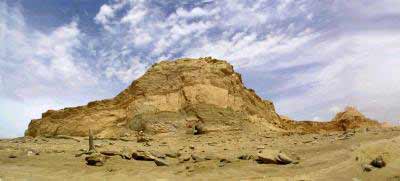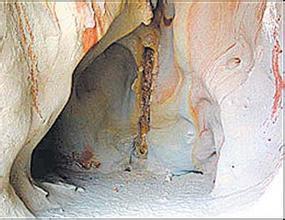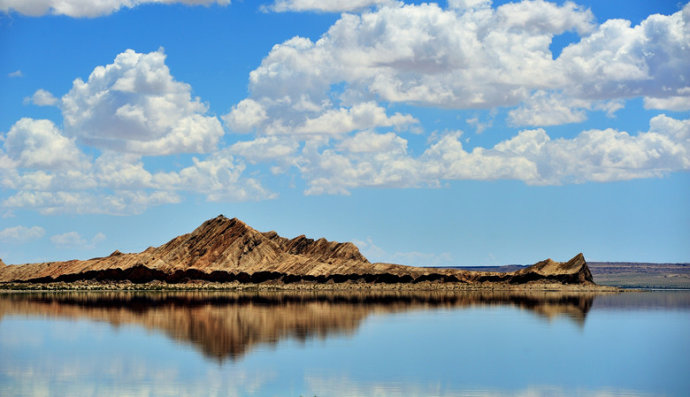
Research & Translation by Adrian Chan-Wyles (PhD)
The Western paranormal and conspiracy theory communities are awash with tales of ‘out of place artefacts’, and government agendas to keep this information ‘hidden’ from public scrutiny. I am not contesting that some governments ‘lie’ to the masses, but am instead applying simple rational and logical research standards to certain topics involving alleged alien visitation of earth, and the supposed notion of alien technology found on earth. To be fair, I possess the ability to access the Chinese internet and to read Chinese language articles – attributes that give me an advantage over those who are unable to do these things (for various reasons). People unfamiliar with Chinese culture, and who cannot read or write the Chinese language, cannot check for themselves the details of any stories they are told to them in their own respective languages. One such subject is the so-called ‘Baigong Pipes’ in Western sources, (although this name is not generally used or recognised within Mainland Chinese sources). Briefly stated, the Western ‘paranormal’ version of this story states that in a remote and mountainous area of China’s Qinghai province, there exists several ‘pipes’ (of various length) running through rock formations that are hundreds of thousands of years old, and apparently made of ‘iron’. As there is no evidence of human habitation in the area – the story continues – the logical conclusion is that the pipes must have been built by visiting aliens from another civilisation in the universe. Just why this is ‘logical’ is open to debate, but from a scientific perspective, this is groundless conjecture without a shred of justifying evidence. Playing the speculative game for a moment, if aliens were to visit the earth and ‘build’ pipes, why not build these pipes of a substance yet unknown on earth? Why build these structures out of common iron? This type of thinking is cyclic and leads nowhere in the process of securing reliable knowledge. The problem with this type of paranormal story is that the ‘facts’ are continuously morphed into unrelated new ideas and hitherto unexplored dimensions of imagination. As those who spread these stories cannot ‘check’ Chinese language sources, the Western version takes on a religious air of theological certainty which is expressed as ‘faith’ in the teaching. This process appears to be a general policy of trying to usurp modern science, and replace it with a re-invigorated ‘theology’ that presents ‘mystery’ as ‘fact’.

Mount Baigong (白公山) is situated in the Qaidam Basin area of the Haixi Mongol and Tibetan Autonomous Prefecture of Qinghai Province, Western China. The Qaidam Basin exists at high altitude, and as it possesses thin air and very few clouds, the sky is unusually transparent and is the ideal place to observe the celestial universe. So much so, in fact, that in 1984, the Chinese Academy of Sciences established the Mount Zijin (紫金山 – Zi Jin Shan) Observatory in Delingha area. Officially this is known as the Qinghai Astronomical Station, and the site was chosen specifically because of its dry and clear air, which makes it easier to transmit radio-signals into space from the earth. And to receive radio-signals (of various kinds) travelling from space into the earth’s atmosphere. As Delingha is the closest city to Mount Baigong, indigenous Chinese language sources refer to this subject as being the ‘Delingha’ pipes, although the term ‘alien’ is often included in the description (for reasons I shall explain shortly). The only descriptions that use the designation ‘Baigong Pipes’ arise from straight translations into the Chinese language of Western articles on the matter. Although China possesses its own ‘Wiki’ on-line encyclopaedia, I have found examples of ‘fake’ or ‘mirror’ Wiki-sites presenting only the Western view in Chinese language translation – the ‘Baigong Pipes’ is such a page. This is revealed by the fact that legitimate Mainland Chinese language sites discussing this issue contain very different information.

Chinese archaeologists have found evidence of human habitation in the Qaidam Basin area of Mainland China dating to around 30,000 years ago and not before. This fact suggests that if the so-called ‘pipes’ are far older than this date, then they must be natural in origination. The Western narrative suggests that US scientists looking for dinosaur-eggs in the area, first discovered hundreds of these ‘pipes’ and reported the find to the Chinese Authorities – but no evidence of this claim exists within Mainland Chinese news or academic sources. In fact, in 1996, a book was published in Mainland China entitled ‘Entering Qaidam’ (走进柴达木 – Zou Jin Chai Da Mu), which described unusual ‘alien-like’ structures discovered in the Tousu (托素) Lake area of Qinghai province.

The author – ‘Bai Yu’ (白渔) – is the honorary chairman of the Qinghai Writers Association, and was motivated to explore the unique geological structures found in the area. To date, this book is not mentioned in any Western sources. Bai Yu states that whilst exploring east of Tousu Lake, (at the foot of the Baiyin Nuowa (巴音诺瓦山) Mountain (range), he found a triangular cave entrance (and interior) that he thought had been artificially created from the pure sandstone. Whilst traversing through the cave, he came upon pipe-like structures that again looked ‘manufactured’. Whilst exploring the rest of the area, Bai Yu discovered many more of these iron-looking pipes, which motivated him to take samples, which he later sent to the ‘Department of Metallurgy’ for testing. According to Bai Yu, the results suggested that the structures were hundreds of thousands of years old. And although comprised of common metal elements, around 8% of the substance tested was unidentifiable. Seizing upon this idea of ‘unknown’ elements, and considering that the primitive people of the area could not have ‘smelted’ these pipes, Bai Yu concluded that perhaps ‘aliens’ had landed on earth a very long time ago and constructed the pipes (perhaps to assist humanity in some way). Bai Yu added to this theory when he discovered the Mount Zijin Observatory in Delingha area – placed there because of the excellent conditions for peering into space. If humans could ‘see’ into space – Bai Yu theorised – perhaps ‘aliens’ could ‘see’ into earth. This being the case, these aliens came down to the Qaidam Basin area, dug-out the caves, built the pipes and then left. Although I cannot find a direct link between Bai Yu’s speculation and the Western version (which is very similar in structure and intent), it is logical to assume that Bai Yu’s story has permeated into the West unreferenced (possibly through the Chinese diaspora).

As Bai Yu’s book became very popular for a time, its content attracted the attention of the government of China. This eventually led to Professor Zheng Jiandong (郑剑东) – of the China Seismological Bureau’s Institute of Geology – leading an academic expedition to the Qaidam Basin area in May, 2001. The first observation was that due to tourism into the area (following the publicity surrounding Bai Yu’s book), much of the surface archaeology had been disturbed and destroyed. The second observation was that the so-called ‘pipes’ existed in widely varying sizes and shapes, with no obvious consistency in the design. Wang Wenguang (王文广), a senior engineer at the Beijing Institute of Geology (currently working in the nuclear industry), has compared samples of these ‘pipes’ with the lunar material (and meteorites) for trace elements, and has found that the pipes are completely different from them. These findings scientifically prove that these (Baigong) ‘pipes’ were not brought to the earth and constructed by aliens in the distant past. At the same time, Professor Zheng Jiandong, by a method called ‘thermoluminescence’ (热释光测 – Re Shi Guang Ce) a study of isotopes, measured the age of the iron ore samples as being around 450,000 years old (Western narratives suggest 150,000 years), which means that the ‘pipe’ structures could not have been constructed by humans. The final determination of the sample is that it was comprised of carbon and pyrite cement, of a non-artificial origination. Furthermore, the previously ‘unknown’ 8% of the elements were clearly identified as being potassium, aluminium, sodium and so on. Academic opinion in China agrees that the pyrite construction is the product of a long and drawn-out (natural) geological process, and not the product of ‘aliens’ visiting the earth. The logical theory is that millions of years ago, substantial (torrential) flooding in the Tousu Lake area, creating the caves and depositing iron-ore in the interior, a process that formulated the ‘pipe-like’ structures through rapid burial. Pyrite was formed through the combination of hydrogen sulphide gas (caused by decomposition) with the iron-ore. However, Zhou De’an (周德安) and other academics are of the opinion that the above process would not probably lead to such perfect ‘pipe-like’ structures. Therefore, academics turned their attention to the study of shrimp fossils found in the area that date to around 40 million years ago. At that time, the Qaidam Basin area was under sea. Later, orogenic-shift produced the Qinghai-Tibet Plateau and the Himalayas, and led to changes in the surrounding environment and climate. Experts believe that these changes created the external causes that led to the formation of the ‘pipe-like’ structures around Tousu Lake. As the Qaidam Basin formed the seabed, when the earth’s plates ‘moved’, the landmass was ‘squeezed’ together and this formed ‘cracks’ in the rocks that formed the caves. Lava-flow issuing through these cracks eventually cooled and formed the pipes. This theory has been used to explain the higher than normal radio-active uranium readings. Arguments against this theory state that there is no evidence of magma ever being present in the area, and the rocks do not exhibit signs of being melted by the immense heat of the lava-flow. A further argument against the magma theory is that if true, there would not be an oil field in the Qaidam Basin. Finally, millions of years ago, the Qaidam Basin area was subtropical, covered in vegetation and trees, and prone to continuous flooding. When trees were uprooted by the floods, they began the long geological process of fossilisation. The trees were buried under thousands of metres of soil, and as the oxygen diminished, the oxidisation process began (through immense pressure and high temperature), and the wood rotted away, leaving iron-ore and other elements present in its place. If correct, this would explain the general shapes of the pipes, and the irregular size and shape. Generally speaking, this matter is still under investigation, but the cause of these ‘pipes’ have been proven to be entirely ‘natural’ in origin.
©opyright: Adrian Chan-Wyles (ShiDaDao) 2017.
Chinese Language Source Articles:
Chinese Language Search Engine: Baidu (百度) https://www.baidu.com (Accessed 10.3.2017
Search Terms: ‘德令哈市, 管, 神秘管, 新华’ (Delingha City pipe, mysterious pipe, Xinhua)
青海德令哈托素湖畔的“外星人遗址”(Qinghai Delingha Tuosu Lake “Alien Ruins Site”)
http://blog.sina.com.cn/s/blog_abdc61670102wc3o.html (Accessed 10.3.2017)
无人区高放射性神秘铁管是外星人遗迹吗 (Are the Highly Radio-Active Pipes of Non-Human Alien Design?)
http://news.xinhuanet.com/tech/2006-06/14/content_4737492.htm (Accessed 10.3.2017)
德令哈外星人遗址 (Delingha Alien Ruins Site)
http://www.qh.xinhuanet.com/2013-05/16/c_115792228.htm (Accessed 10.3.2017)
English Language References:
150,000-Year-Old Pipes Baffle Scientists in China: Out of Place in Time?
http://www.ancient-origins.net/ancient-technology/150000-year-old-pipes-baffle-scientists-china-out-place-time-001783 (Accessed 10.3.2017)
China’s Baigong pipes, “alien” anti-clogging technology or natural formations?
https://truestrange.com/2009/01/03/do-chinas-alien-baigong-pipes-borrow-technology-from-biology/ (Accessed 10.3.2017)
150,000-Year-Old Pipes Baffle Scientists in China: Alien Visit
http://theunexplainedmysteries.com/baigong-pipes.html (Accessed 10.3.2017)

Hello Ben! From what I gather, the site is remote and I seem to remember an issue of visitors damaging the structures, etc. Like everything in China, it all depends on getting the approach correct. It might be a good idea to print-out an article in Chinese about the pipes and keep it on you for illustrative purposes (there’s a few included with my article). As you know, language barriers can still exist due to unknown expressions or local peculiarities in description, etc. The real issue will be one of safety where the local people may not want to take responsibility if you head into the hills unassisted! Another avenue might include approaching an academic institute. When this happens there is usually no problem of access. Good Luck with your visit!
LikeLike
Yes, I still get bothered about all the ‘restricted zone’ nonsense regarding the Shaanxi burial mounds. Ridiculous, considering the majority of them are in the immediate vicinity of the Xi’an airport.
I asked you about the “pipes” in particular because I’m heading to Qinghai next week and I wonder how easy the site is to actually get to. I’ll be travelling with my Chinese-speaking girlfriend, so that might help. Do you have any tips?
LikeLike
Thank you Ben! Much of how the West perceives China is through the mystical filter of the ‘Mystic East’, which is as much racist as it is historically and culturally inaccurate. This issue is not viewed in China as it is in the West – and maybe compared to the other false Western idea that ‘pyramids’ exists in China. The conspiracy theorists state that China is ‘closed’ and so no one can go to these places to investigate, again this is false. Westerners travel in and out of China all the time – particularly to the areas concerned here. The so-called pyramids can be visited by anyone – and they have been exactly identified not as pyramids but rather as Han Dynasty tombs (possessing large and flat terraces not found on the classic pyramid). Again, the Baigong ‘pipes’ are well known and visited all the time – despite their remote positioning and the fact that souvenir hunters have damaged the structures over the years. As I can read the written Chinese language, I simply accessed the relevant research via the Chinese language search-engine ‘Baidu’. Thank you for your kind words.
LikeLike
This is a very informative post on the site, and a quite welcome change from the usual things promoting ancient aliens. Are the pictures here all from a visit of your own as well?
LikeLike